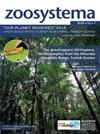An updated checklist and a DNA barcode library for the earthworms (Crassiclitellata, Oligochaeta) of Corsica, France
IF 1.2
3区 生物学
Q3 ZOOLOGY
引用次数: 2
Abstract
ABSTRACT Available studies of the earthworm fauna of Corsica reported a total of 36 species, but this regional diversity is probably underestimated considering the relatively modest sampling efforts achieved so far. We conducted a sampling campaign in the context of the program “Our Planet Reviewed”, with the aim to increase sampling coverage and to analyze already known regional diversity with a combination of classical morpho-anatomic characters and DNA barcoding. We sampled a total of 31 locations, and identified 22 previously recorded species and eight new citations belonging to the families Acanthodrilidae Claus, 1880, Hormogastridae Michaelsen, 1900 and Lumbricidae Rafinesque-Schmaltz, 1815. We obtained 525 COI barcodes which clustered into 48 genetic lineages, highlighting the importance of molecular techniques for earthworm diversity surveys. Of these lineages, ten are supported by multiple lines of evidence and will be described in a forthcoming taxonomy paper as species new to science. Biogeographical affinities of the identified species showed a lower rate of cosmopolitan species compared to other Mediterranean islands, a certain degree of affinity with Italy and Sardinia, and a high rate of endemism (which could be mirrored by the Balearic Islands and Sardinia). Comparative phylogeographic analyses are needed to understand the history of colonization and diversification of earthworms on Mediterranean islands, and to investigate the drivers that shaped differences in their diversity. RÉSUMÉ Liste actualisée et bibliothèque de codes-barres ADN pour les vers de terre (Crassiclitellata, Oligochaeta) de Corse, France. Les études disponibles sur la faune lombricienne de la Corse font état d'un total de 36 espèces, mais cette diversité régionale est probablement sous-estimée si l'on considère les efforts d'échantillonnage relativement modestes réalisés jusqu'à présent. Nous avons mené une campagne d'échantillonnage dans le cadre du programme « La Planète Revisitée», avec comme objectif d'augmenter la couverture d'échantillonnage et d'analyser la diversité régionale en combinant l'utilisation des caractères morpho-anatomiques classiques à celle des codes-barres ADN. Nous avons échantillonné un total de 31 sites, ce qui a permis d'identifier 22 espèces précédemment citées et huit nouvelles signalisations appartenant aux familles Acanthodrilidae Claus, 1880, Hormogastridae Michaelsen, 1900 et Lumbricidae Rafinesque-Schmaltz, 1815. Nous avons obtenu 525 codes-barres ADN qui nous ont permis de délimiter 48 lignées génétiques, soulignant l'importance des techniques moléculaires pour inventorier la diversité des vers de terre. Parmi ces lignées, dix sont soutenues par la morphologie et seront décrites comme espèces nouvelles pour la science dans un article de taxonomie à venir. Les affinités biogéographiques des espèces identifiées montrent un taux relativement faible d'espèces cosmopolites par rapport à d'autres îles méditerranéennes, un degré d'affinité avec les faunes italiennes et sardes, et un taux élevé d'endémisme (qui pourrait être équivalent à celui des îles Baléares et de la Sardaigne). Des analyses phylogéographiques comparatives pourraient aider à comprendre l'histoire de la colonisation et la diversification des faunes de vers de terre des îles méditerranéennes et à comprendre les facteurs qui ont façonné les différences dans leur diversité.法国科西嘉岛蚯蚓(Crassiclitellata, Oligochaeta)的更新清单和DNA条形码库
科西嘉岛蚯蚓动物群的现有摘要研究报告了总共36个物种,但考虑到迄今为止所做的相对适度的采样工作,这种区域多样性可能被低估。我们在“我们的星球回顾”计划的背景下开展了一项采样活动,旨在通过结合经典形态解剖特征和DNA条形码,增加采样覆盖率,分析已知的区域多样性。我们总共采样了31个地点,并确定了22个以前记录的物种和8个属于棘科克劳斯的新引文,1880年,Hormogastridae Michaelsen,1900年和Lumbricidae Rafinesque Schmaltz,1815年。我们获得了525个COI条形码,这些条形码聚集在48个遗传谱系中,强调了分子技术在蚯蚓多样性调查中的重要性。在这些谱系中,有十个由多条证据线支持,并将在一篇即将发表的分类学论文中描述为科学新物种。与其他地中海岛屿相比,已确定物种的生物地理亲和力显示出较低的世界性物种比率,与意大利和撒丁岛的亲和力程度较高,以及较高的地方性比率(巴利阿里群岛和撒丁岛可能反映了这一点)。需要进行比较系统地理学分析,以了解地中海岛屿蚯蚓殖民和多样化的历史,并调查形成其多样性差异的驱动因素。法国科西嘉岛蚯蚓(Crassiclitellata,Oligochaeta)的最新列表和DNA条形码库摘要。对科西嘉岛蚯蚓动物群的现有研究报告共有36种,但考虑到迄今为止相对较小的采样努力,这种区域多样性可能被低估。作为“重访地球”计划的一部分,我们开展了一项抽样活动,目的是通过结合使用经典形态解剖特征和DNA条形码,增加抽样覆盖率并分析区域多样性。共对31个地点进行了采样,确定了22个先前引用的物种和8个新的报告,分别属于Acanthodrilidae Claus科,1880年、Hormogastridae Michaelsen科,1900年和Lumbricidae Rafinesque Schmaltz科,1815年。我们获得了525个DNA条形码,使我们能够划定48个遗传谱系,强调了分子技术在清点蚯蚓多样性方面的重要性。在这些谱系中,有10个得到了形态学的支持,并将在即将发表的分类学文章中被描述为科学的新物种。已鉴定物种的生物地理亲和力表明,与其他地中海岛屿相比,世界性物种的比例相对较低,与意大利和撒丁岛动物群的亲和力程度较高,特有率较高(可能相当于巴利阿里群岛和撒丁岛)。比较系统发育分析有助于了解地中海岛屿蚯蚓动物群的定居和多样化历史,并了解影响其多样性差异的因素。
本文章由计算机程序翻译,如有差异,请以英文原文为准。
求助全文
约1分钟内获得全文
求助全文
来源期刊

Zoosystema
生物-动物学
CiteScore
2.00
自引率
10.00%
发文量
18
审稿时长
>12 weeks
期刊介绍:
Zoosystema is a fast-track and peer-reviewed journal, devoted to the inventory, analysis and interpretation of animal biodiversity. It publishes, in French or English, original results of zoological research, particularly in systematics and related fields: comparative, functional and evolutionary morphology, phylogeny, biogeography, taxonomy and nomenclature, etc. All articles published in Zoosystema are compliant with the different nomenclatural codes. A copyright assignment will be signed by the authors before publication.
 求助内容:
求助内容: 应助结果提醒方式:
应助结果提醒方式:


